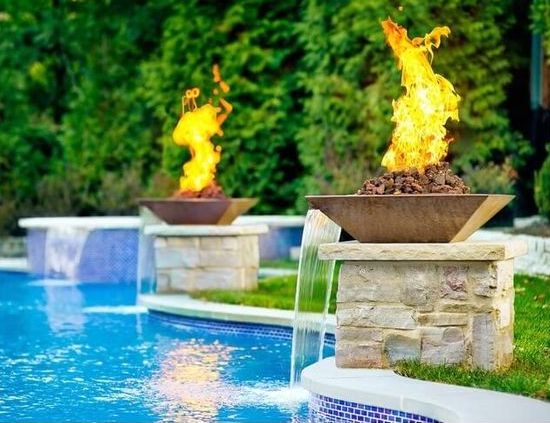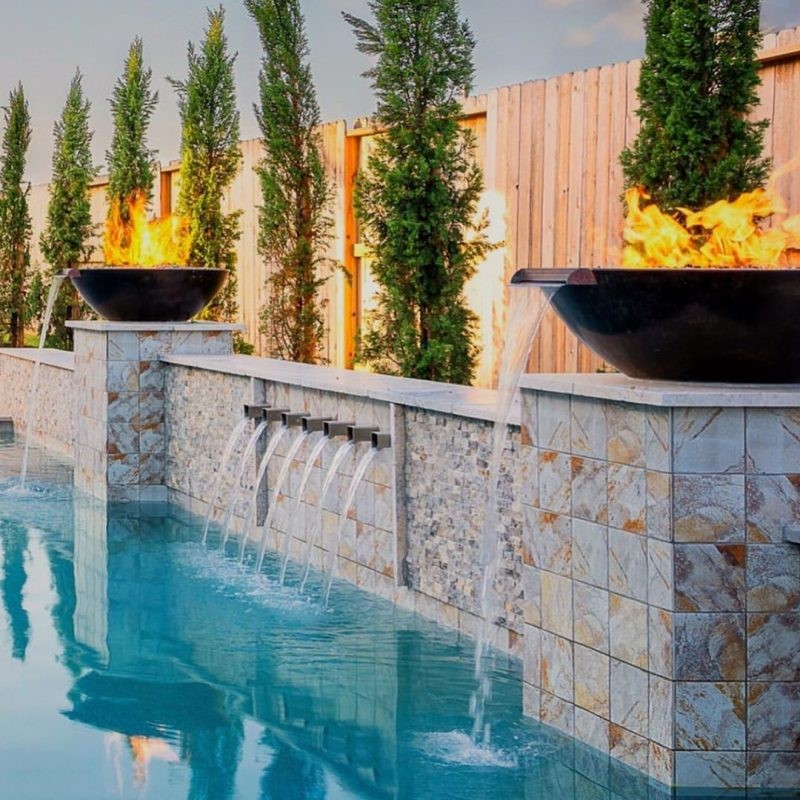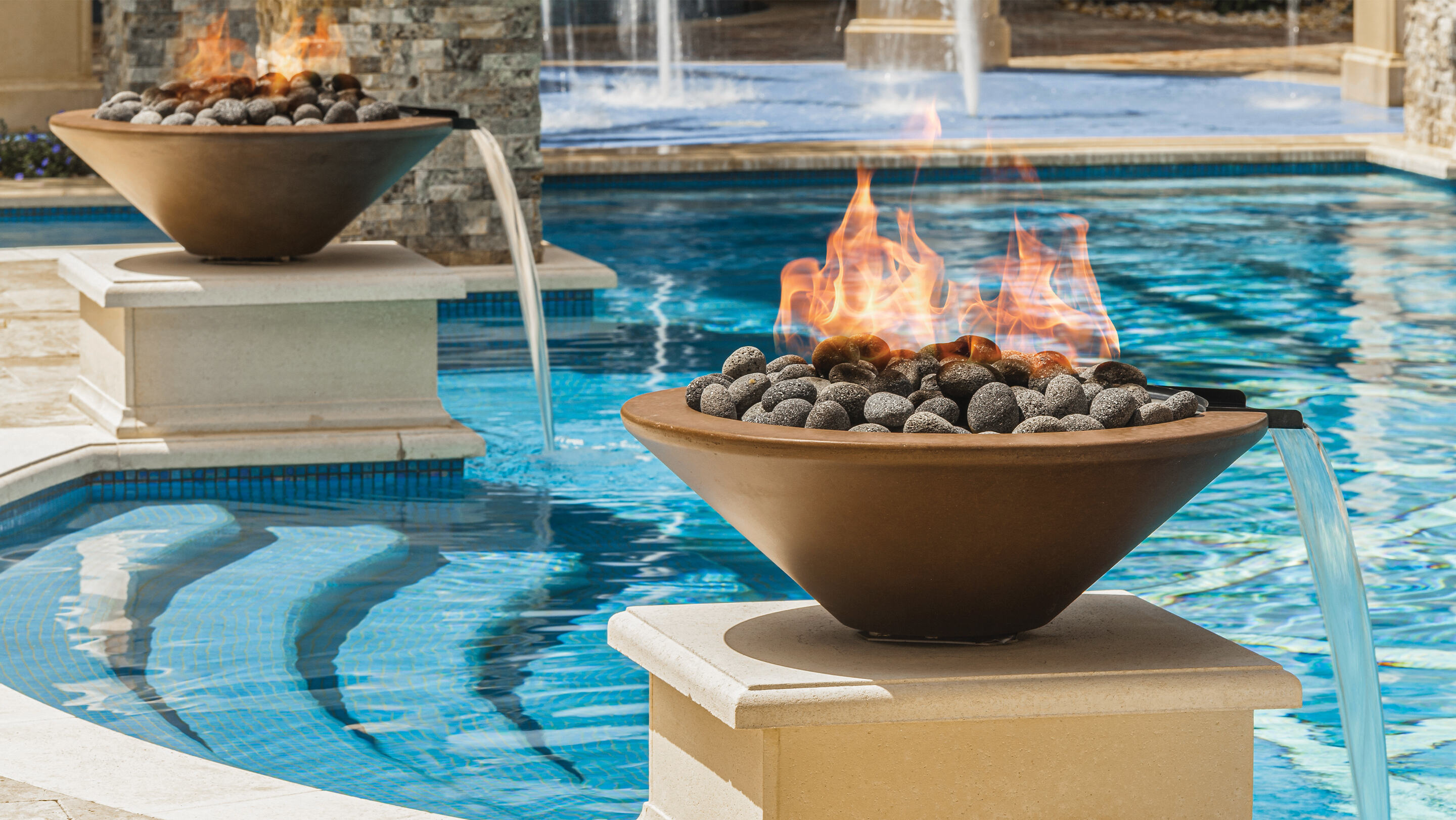Call us at 725-239-9966!
M-F: 8 AM-7 PM PST
Call us at 725-239-9966!
M-F: 8 AM-7 PM PST

Fire and water features are the hottest new trend for stylish and multifunctional outdoor spaces. Combining the mesmerizing dance of flames with the soothing sounds of cascading water, these patio fire features create an unforgettable sensory experience perfect for relaxation or entertainment.
If you’re interested in adding one of these visually stunning fire, and water bowls to your outdoor décor, this guide will provide you with everything you need to know. Let's begin!

With so many varieties and options for water and fire bowls, selecting the perfect model for your needs may feel overwhelming initially. Keep these essential factors in mind as you evaluate products:
Water and fire bowls are commonly constructed from concrete, copper, or stainless steel, with each material offering its own advantages.
Concrete Fire Bowls
Copper Fire Bowls
Stainless Steel Fire Bowls
When selecting a material, consider visual appeal, weight, durability, and ongoing maintenance requirements. Concrete and stainless steel are lower maintenance than copper but may sacrifice aesthetics.
Water and fire bowls span a range of sizes, reaching up to 5 feet in diameter for sprawling commercial venues. Measure your intended location first before deciding on dimensions. Standard residential bowls usually fall between 30 to 45 inches across.
Bigger bowls make visual statements for large patios but require more fuel and burn hotter. Smaller bowls nicely fit constricted spaces and offer more affordable long-term operation. Evaluate both form and function when choosing a bowl scale.
Water and fire bowls come in a variety of shapes and styles to match any outdoor décor. While features may vary slightly based on manufacturers, most models fall under two main categories:
The most popular and affordable option, these versatile units stand alone and contain all necessary components within the body of the bowl. They operate with propane or natural gas and feature control panels to adjust flame height, water flow, timers, and more.
Self-contained portable bowls can sit near pools, on patios, decks, courtyards, or any flat surface. Their lightweight concrete, metal, or ceramic construction allows you to reposition them easily.
For a sleek, seamless look, custom built-in bowls are installed directly into patios, pool surrounds, or landscaping beds. While more expensive, their permanent integration lets you customize sizes and materials to perfectly match your existing space. Most models offer remote controls or switches to operate the fire and water. Gas lines or propane tanks are installed underground for clean appearance.
Fire bowls typically use natural gas, propane, or bioethanol as fuel sources. Each has pros and cons:
While water and fire functionality remains essential, let’s not overlook stylistic appearance. After all, these bowls will prominently anchor your outdoor living space design for years. Select colors and materials that integrate nicely with surrounding hardscapes.
Natural stone and wood-inspired composite blends especially complement backyard environments. Or make a contemporary style statement with sleek stainless steel and glass water walls. Match any pool waterlines for a cohesive look.
Consider installing coordinating landscaping with heat-tolerant plants and hardscapes as well. Properly designed, the entire patio can complement your gorgeous new water and fire bowl look.
When selecting a water and fire bowl, look for key safety features such as emergency gas shutoffs to quickly stop the flow of fuel if needed. Removable mesh screens can prevent embers from getting out and starting accidental fires.
Checking that any model you choose meets local fire codes for outdoor fire pits is important to ensure legality and safety.
In addition to basic fire bowl functionality, some models offer convenient extra features.
Consider which special add-ons suit your needs and budget. The latest innovations promote better experiences yet can add more upfront and ongoing costs over a standard fire pit.
While mesmerizing flames and soothing water may tempt impulse buying, don’t forget to evaluate potential long-term costs for your fire and water bowl. As touched on regarding fuel types earlier, some options like bioethanol burn clean but prove quite pricey over months and years of use.
Alternatively, natural gas offers affordability at the expense of professional installation and hookups. And even standard propane requires ongoing tank refilling and replacement expenses. Review estimated yearly costs for any model you consider to avoid budget surprises.
Fire and water bowls range dramatically regarding BTUs and overall heat generation. Smaller units may suffice for providing ambient warmth on cool evenings. Yet during frigid winters or in colder climates, investing in a more BTU beast brings much needed heat. Just don’t get carried away placing too large a fire feature in tight spaces which turn searing hot quickly.
Always verify that bowl construction and included materials can withstand max flame heights and temperatures over extended operation. And situate your fire pit safely away from children’s play areas, seating areas, or flammable patio materials.

Proper installation is vital to ensure proper water flow, adequate drainage, and of course critical safety precautions. Here’s what you need to consider:
Professional Recommended: Unless you’re an experienced plumber and electrician, have a landscaping company that specializes in water features perform the installation.
Permits: Verify whether you need special permits based on your county’s fire code restrictions and homeowner’s association regulations. Better to check first rather than risk fines down the road.
Prep the Site: Mark underground pipes and wires to prevent damage. Install proper drainage and a non-combustible base protecting surrounding surfaces from heat.
Safety First: Ensure adequate clearance from structures and vegetation. Add metal heat shields when putting fire bowls on wooden decks. Install emergency gas shut-off valves and anchor freestanding models properly.

Water and fire bowls uniquely combine classic elements for comfort through every season. As an excellent alternative to traditional fire pits, their dancing flames and gentle water create ambient backyard spaces sure to impress guests while providing lasting memories for families.
Hopefully, this buyer’s guide gave you all the details needed when considering adding fire and water bowl combination to your own outdoor living areas. Feel free to contact our team with any specific questions not already answered about selecting the perfect products to match your needs, budget, and dreams. We look forward to helping you create your ideal backyard paradise!
Fire bowls usually have a more compact and versatile design than fire pits, and they often serve as an attractive accent piece for your outdoor space. On the other hand, fire pits tend to be larger and can provide more heat, which can be beneficial if you're hoping to gather a large group around it.
Pool water bowl features require some maintenance, but it’s usually minimal. For fire bowls, maintaining the fuel supply is the primary concern. Water bowls may require occasional cleaning or adjustments to the pump. Both types generally need seasonal protection from the elements.
Fire bowls can generate substantial heat, with some gas fire bowl models reaching some of the hottest temperatures. While they may not provide the same amount of heat as a larger, built-in fireplace, they can still create a cozy ambiance for your outdoor patio.
A fire feature can add a fire or water to create a focal point, make your outdoor space more attractive, and provide a place to gather and enjoy. In addition, if you choose a self-contained water or fire bowl, you can enjoy the sounds of water or the warmth of fire with just the push of a button.
To create the ultimate fire bowl setup, first-time buyers need to consider the size of their patio, the bowl’s heat output, whether they desire fire, water, or both, and what kind of ambiance they want to create. An outdoor features buying guide can assist in making these decisions.

{"one"=>"Select 2 or 3 items to compare", "other"=>"{{ count }} of 3 items selected"}